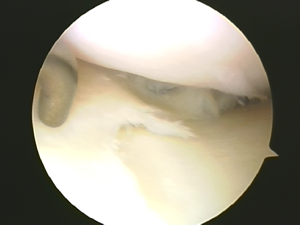|
KNEE AND SURGERY
|
||||||
| English version of the website of Dr. J.E.Perraudin, french orthopaedic surgeon in paris : www.docteurperraudin.com : the content is intended for general information only and does not replace the need for personal advice from a qualified health professional. Last updated Feb 12, 2017 | ||||||
|
Knee Arthroscopy
|
||||||
| Arthroscopy allows an orthopaedic surgeon
to diagnose and treat knee disorders by providing a clear view of
the inside of the knee with small incisions, using a pencil-sized
instrument called an arthroscope. The scope allows transmission of
images to a television monitor. The surgeon watches the
images on the TV monitor to thoroughly examine the interior of
the knee and determine the source of the problem. During the procedure,
the surgeon can insert surgical instruments through other small incisions
in your knee to remove or repair damaged tissues. The incisions are
closed by paper strips or a stitch.
After arthroscopic surgery Recovery is fast after arthroscopic surgery. As soon as he awakes from anaesthesia, the patient does simple exercises for strengthening the muscle of the thigh (quadriceps). He can walk without crutches and take weight through the operated knee but he must keep his leg straight for a few days by contracting his quadriceps (no crutches, no brace). On the day after, he can flex his knee in bed and while sitting. If necessary, he will make passive flexion exercises. After a few days, he feels better and it will be possible to walk normally. After ten days, the patient takes off the paper strips. Indications of arthroscopy: The most frequent indication of arthroscopy is partial meniscectomy (removing of the damaged part of the cartilage meniscus). This is a very common procedure. In some cases (young patient and a special type of meniscus damage), a suture can be discussed. The purpose of suture is to expect a healing of the lesion. When the knee is locked (inability to fully straighten the leg),
the lesion is called a "bucket
handle tear". It is frequently associated with an ACL injury
which must be looked for. |
||||||
|
|
||||||
| Other images | ||||||
| Docteur J.E.
Perraudin ; last updated Sept 2012 |
||||||
